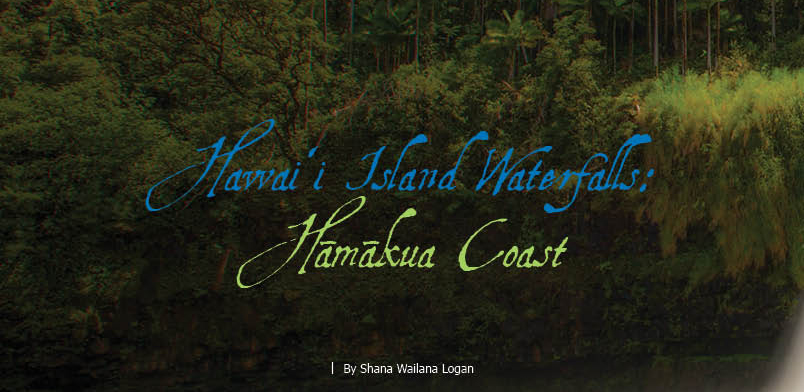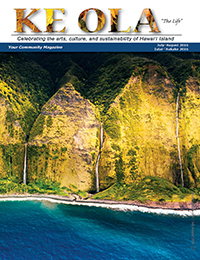
Hawai‘i Island Waterfalls: Hamakua Coast
By Shana Wailana Logan
| “He Mele no Kāne He Wai a KāneAia i-hea ka Wai a Kāne? Aia i-lalo, i ka hōnua, i ka wai hu, I ka wai kau a Kāne me Kanaloa He wai-puna, he wai e inu, He wai e mana, he wai e ola. E ola no e-a! |
The Song of Kāne The Water of KāneWhere flows the water of Kāne? Deep in the ground, in the gushing spring, In the ducts of Kāne and Loa, A well-spring of water, to quaff, A water of magic power, The water of life! Life! O give us this life!” |
(Unwritten Literature of Hawaii, by Nathaniel B. Emerson, 1909)
Kumu Wai
Mauna Kea rains drift slowly on the winds across the alpine shores of sweeping coastline, creating spectacular rainbows and majestic waterfalls along a steep, green terrain of rivers and valleys. Waves crash upon the powerful boulders and river rocks by the sea. Misty cool forests of lehua filled with the scent of wild yellow ginger and sweet, red ‘awapuhi (ginger) beckon the explorer to venture beyond its edges to enter into a world of tropical splendor and timeless beauty. Waterfalls abound, cascading down hundreds of feet into rivers that go on for miles through lush jungles and tall pali—the high mountain cliffs where pueo (owl) and koa‘e (sea bird) perch.
This is the Hāmākua Coast, a section of Hawai‘i Belt Road (Māmalahoa Highway) which straddles the northeast side of Hawai‘i Island from a portion of South Hilo to South Kohala.
Hāmākua means “breath of the parent,” an ancient metaphor for the area which once was the breadbasket for the entire island.
Mauna Kea, known as the piko, the center of Hawai‘i Island, is the kumu wai, the water source for this area which holds a sacred connection with Hawaiians.
Poli‘ahu
Poli‘ahu, the Hawaiian deity of snow, is a benevolent goddess who dwells on the highest peaks of the mauna (mountain). She provides clean water downstream through a network of rivers and streams flowing with melted ice above the surface as kahawai (rivers) and wailele (waterfalls), as well as deep below the ground through rock and ancient lava tubes now filled with water that eventually spill into the sea.
In Hawai‘i, it is known that what happens up mauka (in the mountains) ends up in the makai (coastal areas).
Waterfalls are an indicator of the conditions upstream: if the water is flowing and clear, it’s a good sign that everything upstream is clean and flowing. If there’s brown or discolored waterfalls, it shows tainted or polluted water, perhaps from a heavy rain or storm that caused runoff to filter into the water up above. The worst sign is when a waterfall and its accompanying river goes dry, indicating a blockage or diversion that must be addressed upstream for the health of the water and all it feeds downstream.
Wai a Kane
Kāne is the supreme deity believed to be the keeper of this precious element of water, the “giver of life” to the earth and all who dwell here. People of old knew the importance of wai, fresh water, and they cherished it.

The health of an island can be seen in the purity and vibrance of its water, in particular, its waterfalls, and Hawaiians knew this well, taking it very seriously.
Strict kapu, sacred restrictions and guidelines for human activities in relation to each other and the environment, were conveyed by lifelong teaching and instruction using mo‘olelo, ancient stories.
Some mo‘olelo (legends) tell of the guardian deities such as Mo‘oinānea of Lake Waiau atop Mauna Kea, and Kamāpua‘a, of the sacred waterfalls. The mo‘o (lizard) and pua‘a (pig) are commonly seen near waterways and forested landscapes. Mo‘oinānea guards pristine Lake Waiau, assuring it replenishes and is pure enough to use for ceremonies and healing rituals.
The water on Mauna Kea is sacred, being the first, “untouched” water source in the hydrology cycle of the mountain, and Hawaiians cherished it as the purest. Today, Hawaiians still pay homage to these deities who are those elemental forces of nature that live and dwell in the water that falls atop this pristine mountain.
Kamapua‘a of Sacred Falls
Kamapua‘a was an infamous half man-half pig demigod said to be born on the island of O‘ahu at Kaliuwa‘a, Sacred Falls.
In Hawai‘i, one cannot tell a story of waterfalls without mentioning this significant presence in Hawai‘i’s ancient mythology, whose history spans all the islands, his footprint deep within the soil.
As a man, he came to the island of Hawai‘i to court the volcano goddess, Pele. Their courtship was a tumultuous one, ending in the division of the Hawaiian Islands, with the Wailuku River in Hilo as a dividing line between Pele’s area of South Hilo, Puna, and Ka‘ū, and the domain of Kamapua‘a, stretching from South Hilo on the Hāmākua coast all the way up north to the island of Kaua‘i.
Kamapua‘a was also known for his various kinolau, the natural forms he could transform into. He could change into the ‘amau‘u fern and the kukui nut tree, (both are often found near waterfalls), as well as the humuhumunukunukuapua‘a fish (reef triggerfish, our state fish), and a handsome young man full of charm and clever wit.
Today, his presence is known by the many pua‘a (pigs), seen roaming the valleys, guarding the sacred area of the waterfall.
‘Akaka Falls
‘Akaka Falls in South Hilo on the Hāmākua Coast is famous for its beauty and folklore.
Located in the peaceful village of Honomū, Hawaiians once told the story of the falls, where a handsome young warrior named ‘Akaka lived with his wife. He loved her dearly, making a home for them in the lush forest, along with his faithful dog.
However, he also had love for two goddesses, Maile and Lehua, who both fell deeply in love with him, and would wait for him in the forest glen until he would come for them while his wife was away.
One day, his beloved wife found out about his affairs and when she confronted him, ‘Akaka fled into the forest with his trusting dog at his side.
Deeply saddened by his own guilt, he became disoriented and lost his life as he crossed over a stream atop a steep waterfall, now known as ‘Akaka Falls, where he slipped and fell to his death more than 400 feet into the pool below.
It is said that his dog was so loyal that he stayed at the top of the falls, waiting for his master so long that he has become a hardened rock perched above. The two maidens, Maile and Lehua, were heartbroken, weeping so hard that many say the smaller falls on either side of ‘Akaka Falls are these very women, still in sorrow for their lover.
Downstream is another smaller flow, Kahuna Falls, which represents his faithful wife, still by his side.
A lovely native fern, wahinenohomauna (the woman who sits on the mountain), is abundant here, and is said to represent these loyal women who still pine for ‘Akaka to this day.
On occasion, one can feel the biting, cold breeze of kani i ke ‘anu, which wafts down from the mountain as a poignant reminder of the coldness now felt for their beloved ‘Akaka, now gone forever, yet still alive in the water that falls here.
Hi‘ilawe Falls
Waipi‘o is “curving water,” which tells of the water that flows and winds through the valley floor filled with kalo (taro) and other important agricultural crops.
It was a large community of warriors and kings, great legends and heroes. Once a robust economy of trade and barter, Waipi‘o has a rich history.
Known as the “Valley of Kings,” it was home to King Kamehameha the first, who united the Hawaiian Islands under one ruler. He lived and worked here, becoming skilled at farm cultivation and land management, as many in this remote village were.
This was a time when their main water source, the Wailoa River, running down through Hi‘ilawe Falls, flowed on a more regular basis, providing an abundance of water for the people here that allowed them to be prosperous and self-sufficient in this remote location.
Unfortunately, the falls have since been for the most part dried up, flowing only after heavy rains up mauka make it down in any substantial amount. Diversions of water upstream have severely depleted this flow.
Those who live in Waipi‘o today face challenges to their livelihoods and self-sustainability as the water above ebbs and flows according to the weather and the activities upstream. Many have worked to continue to make this a special place like it was so long ago, when the waters flowed more freely and life was simpler.
Numerous tales abound in Waipi‘o, the waterfalls being among the more prominent.
The legend of Hi‘ilawe Falls tells of a couple, Hi‘ilawe and Kakalaoa, who ventured into the forests and came upon a chirping ‘elepaio bird. This, in Hawaiian tradition, was a bad omen.
Fearing an unfortunate event, the two held onto each other so tight, they could not let go. Weeping unceasingly, Hi‘ilawe became the falls and her beloved, Kakalaoa, a large boulder at the base of the pool below. The two now can be together forever, as Hi‘ilawe continuously sheds her tears upon Kakalaoa amidst the falls.
Ha‘ina—Waterfall Refrain
Waterfalls in Hawai‘i play a very important role in channelling and flushing out the waters that flow miles down the slopes of these steep volcanic mountains.
Hāmākua can be seen as the largest pakini (container) of water on Hawai‘i Island, and it is everyone’s kuleana, our duty, to mālama, take care of it for future generations to come.
Our island home depends on how we manage our resources. Water is of utmost concern as we embark on new technologies and the population grows, putting more demands on a precious commodity that previously supplied the community with all the water it needed.
At one time, Hawaiians bathed, swam, and drank the waters in the mountains, yet now these same water sources are often tainted with disease and pollution.
For modern Hawaiians and malihini (newcomers) alike, the challenge is to protect and advocate for the rivers, streams, and all sources of water that we depend upon, in whatever capacity one has, including keeping pollution out of our waters.
Everyone in the islands has the opportunity to visit mountains, rivers, streams, waterfalls, yet it takes us all to make sure they are flowing in the right direction, with no pollution, poison, or blockage, flowing with the purity and vibrancy fresh water is meant to embody. ❖



